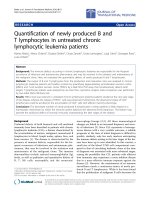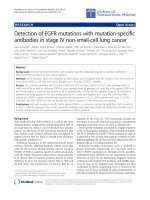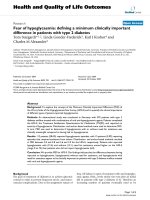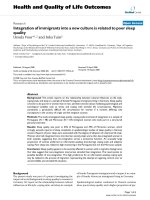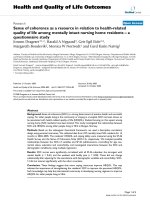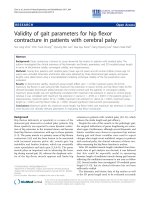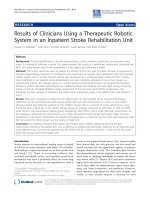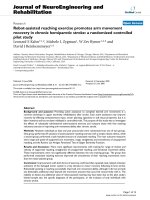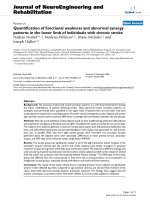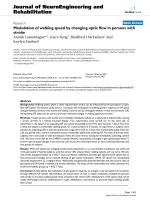Báo cáo hóa học: " Results of Clinicians Using a Therapeutic Robotic System in an Inpatient Stroke Rehabilitation Unit" potx
Bạn đang xem bản rút gọn của tài liệu. Xem và tải ngay bản đầy đủ của tài liệu tại đây (773.11 KB, 12 trang )
RESEARCH Open Access
Results of Clinicians Using a Therapeutic Robotic
System in an Inpatient Stroke Rehabilitation Unit
Hussein A Abdullah
1*
, Cole Tarry
1
, Cynthia Lambert
2
, Susan Barreca
3
and Brian O Allen
4
Abstract
Background: Physical rehabilitation is an area where robotics could contribute significantly to improved motor
return for individuals following a stroke. This paper presents the results of a preliminary randomized controlled trial
(RCT) of a robot system used in the rehabilitation of the paretic arm following a stroke.
Methods: The study’s objectives were to explore the efficacy of this new type of robotic therapy as compared to
standard physiotherapy treatment in treating the post-stroke arm; to evaluate client satisfaction with the proposed
robotic sy stem; and to provide data for sample size calculations for a proposed larger multicenter RCT. Twenty
clients ad mitted to an inpatient stroke rehabilitation unit were randomly allocated to one of two groups, an
experimental (robotic arm therapy) group or a control group (conventional therapy). An occupational therapist
blinded to patient allocation administered two reliable measures, the Chedoke Arm and Hand Activity Inventory
(CAHAI-7) and the Chedoke McMaster Stroke Assessment of the Arm and Hand (CMSA) at admission and
discharge. For both groups, at admission, the CMSA motor impairment stage of the affected arm was between 1
and 3.
Results: Data were compared to determine the effectiveness of robot-assisted versus conventional therapy
treatments. At the functional level, both groups performed well, with improvement in scores on the CAHAI-7
showing clinical and statistical significance. The CAHAI-7 (range7-49) is a measure of motor performance using
functional items. Individuals in the robotic therapy group, on average, improv ed by 62% (95% CI: 26% to 107%)
while those in the conventional therapy group changed by 30% (95% CI: 4% to 61%). Although performance on
this measure is influenced by hand recovery, our results showed that both groups had similar stages of motor
impairment in the hand. Furthermore, the degree of shoulder pain, as measured by the CMSA pa in inventory scale,
did not worsen for either group over the course of treatment.
Conclusion: Our findings indicated that robotic ar m therapy alone, without additional physical therapy
interventions tailored to the paretic arm, was as effective as standard physiotherapy treatment for all responses and
more effe ctive than conventional treatment for the CMSA Arm (p = 0.04) and Hand (p = 0.04). At the functional
level, both groups performed equally well.
Introduction
Stroke remains an international leading cause of partial
or full loss of motor function, with about 75% of indivi-
duals failing to regain functional use of their paretic arm
and hand [1,2]. There is increasing evidence that
enriched, functional, active, and repetitive practice of
movement may have a profound effect on recovering
impaired motor function in sub-populations after a
stroke or an acquired brain injury [3,4]. Animal studies
have shown that, not only practice, but also novel and
varied activities for the upper limb, appear to enhance
synaptic elaboration [5,6]. The Canadian Best Practice
Recommendations advise repetitive and intense use of
novel tasks to challenge individuals to acquire the neces-
sary motor skills [7]. Passive [8,9] and active assistance
upper limb movements [10,11] seem to improve recov-
ery by their effect on somatosensory input, moto r plan-
ning, soft tissue properties, and spasticity. However,
these intensive approaches are often slow, lengthy, and
costly, as they usually require a clinician to work
* Correspondence:
1
School of Engineering, University of Guelph, Guelph, N1G 2W1, Ontario,
Canada
Full list of author information is available at the end of the article
Abdullah et al. Journal of NeuroEngineering and Rehabilitation 2011, 8:50
/>JNER
JOURNAL OF NEUROENGINEERING
AND REHABILITATION
© 2011 Abdullah et al; licensee BioMed Central Ltd. This is an Open Access article dis tributed under the terms of the Creative
Commons Attribution License ( which permits unrestricted use, distribution, and
reprodu ction in any medium, provided th e original work is properly c ited.
individually with patients. A lack of resources may result
in rehabilitation treatment being inadequate in its dura-
tion and intensity, thereby not optimizing functional
return [12]. With the incidence of stroke expected to
rise expone ntially within the next 20 years [7], demand
for therapy is also expected to increase. As health care
resources are limited, technology has the potential to
play a supportive role in rehabilitation. Therefore, it is
timely to investigate more cost effective intelligent sys-
tems that use novel and varied computer programming
to offer additional practice opportunities.
Physical rehabilitation is an area where robotics could
contribute significantly to improved motor return for
individualsfollowingastroke[13-15].Aroboticsystem
with controllable movement velocity and supported by
intelligent sensing capability may be a vital assistant in
today’ s physical therapy centres. Individuals’ data may
be objectively recorded, helping therapists and physi-
cians monitor and evaluate the patient’ sprogressand
the treatment intervention.
Rehabilitation Robotics
During the 1 990s, there was a growing interest in the
field of therapeutic applications of robots [16]. One of
the first contributions to robots in physiotherapy was
conducted at the Rehabilitation Institute of Michigan
[17].Thedevicewasprogrammedtodofivesimple
movement patterns, each consisting of eight points.
Although the literature r eports on many robot-assisted
devices designed to deliver therapy for the paretic upper
limb, only seven have been tested in clinical trials (MIT-
Manus [18-20 ], MIME [21,22], ARM-Guide [23], GEN-
TLE [24], Bi-Manu-Track [25], BATRAC [26] and
REHA-ROB [27]). Six o f the trials reported above used
the Fugl Meye r assessment scale while the ARM trial
used the Chedoke McMaster Stroke Assessment
(CMSA). Sivan at el. have classified and evaluated the
outcome measures currently used in robot-assisted exer-
cise trials (RAET) in stroke through a syst ematic review
published in [28]. They have found that “Chedoke Arm
and Hand Activity Inventory (CAHAI) scale would seem
to be an appropriate activity scale, but has not been
used in RAET” [28].
MIT-Manus is a planar module that provides 2 trans-
lation DOFs (degrees of freedom) for elbow and forearm
motion and repetitive massed practice of reaching
toward an en d point usi ng impedance control [15]. A n
evaluation of this therapeutic robot has been reported in
several studies for treatment of acute and chronic post-
stroke hemiparesis [15 (n = 20), 18 (n = 76), and 19 (n
= 47)]. The results showed that the robotic therapy
group had significantly more improvement in motor
function; however, Brewer (2007) [29] concluded “these
results are not definitive because (a) the control
(conventional therapy) group had significantly poorer
motor and cognitive function at baseline, and (b) the
treatment group received 4-5 hours of traditional ther-
apy c ompared with 30 minutes for the control group” .
The MIME (Mirror-Image Motion Enabler) incorpo-
rated an industrial robot manipulator (Puma 560) that
applied forces to the paretic forearm in 3-dimensional
space [30], where the non-affected arm guided the pare-
tic arm. The MIME used uni-manual and bi-manual
active and passive arm exercises and was directly com-
pared to conventional neurodevelopmental treat ment (n
= 27). The MIME treatment group had greater increases
in strength and reaching. However, there was little dif-
ference between the two groups at 6 months follow up
[29].
The Rehabilitation Institute of Chicago built the ARM
Guide (Assisted Rehabilitation and Measurement) that
has 3-controlled DOF to provide assistive therapy to
patients’ upper extremity with chronic hemiparesis [23].
The ARM assistive therapy compared directly with con-
ventional therapy (n = 19) showed no difference
between the two methods [30]. The GENTLE’ s project
utilized a 3 DOF haptic interface and V irtual Reality
(VR) technologies to enhance patient attention and
motivation [31]. In this clinical trial (n = 20), 10 subjects
used the robot reaching therapy and another 10 used
the sling suspension phase. The trend emerging from
the results showed that the robotic system had a more
positive treatment effect than single plane repetitive
exercises; however, the results lacked statistical signifi-
cance and further research in the form of RCT was war-
ranted. Another system, the Bi-Manu-Track robot,
enabl ed basic bilateral passive and active practise of two
movements, forearm pro-supination and wrist flexion
and extension in a mirror-like or a parallel fashion [25].
In a clinical trial (n = 44) acute stroke patients rece ived
assistive or resistive force robotic therapy. The patients
improved and maintained their advantage three months
after treatment compared to a control group who
received movement practice aided by electrical stimula-
tion [25]. The BATRAC is an apparatus comprised of 2
independent T-bar handles that can be moved by the
patient’s hands (through shoulder and elbow flexion/
extension) on a horizontal plane. Nin eteen patients with
chronic hemiparetic stroke used the system in a single
design group for 6-9 weeks. The patients showed
improvement in several key measures of sensorimotor
impairments, with these improvements maintained two
months after patients stopped training [26]. The
REHAROB therapeutic system uses 2 unmodified ABB
industrial robots. The robots are connected to the
patient’s upper arm and forearm through instrumented
orthoses [27]. Thirty patients with hemiparesis were
divided randomly into two groups, robot and control.
Abdullah et al. Journal of NeuroEngineering and Rehabilitation 2011, 8:50
/>Page 2 of 12
Subjects received 30 minutes of conventional therapy for
20 consec utive work days while subjects in the robotic
group received an additional 30 minutes of robot-
ass isted therapy. This trial concluded that it is useful to
patients to supplement conventional therapy with robot
assisted therapy.
Nevertheless, none of these studies showed functional
improvement. It can be concluded, “a major challenge
for related technological developments is to provide
engaging patient-tailored task oriented arm-hand train-
ing in natural environments with patient-tailored feed-
back to support learning of motor skills.” [32]. Mehrholz
et al. reviewed these trials [33], to asse ss the effectiv e-
ness of robot-assisted arm training for improving activ-
ities of daily living, arm function and motor strength of
patients after stroke. They concluded that although
robot-assisted arm therapy may improve impaired
motor function and strength of the paretic arm, it did
not improve the ability of individual s to perform a ctiv-
ities of daily living post-stroke [33]. Therefore, more
clinical trials are required to determine whether robotic
therapy is feasible in routine stroke rehabilitation. More-
over, these trials would enhance multi-disciplinary team
work between the robot developers, therapists, and
patients to modify and design more clinically effective
devices.
The School of Engineering at the University of Guelph,
in consultation with experienced therapists and physia-
trists, developed a user- friendly intelligent therapeutic
robotic system to provide assistive therapy to patients’
upper limbs after stroke. Its design is unique in that the
robotic arm is not only bio-sensing driven, but also func-
tions in multiple planes including rotational components.
The safety features allow individuals to work in these
multidimensional planes with the robotic arm automati-
call y stopping when clients move their limb beyond phy-
siotherapist established fields. The workspace of the
exercises is limited in the software to ensure that the
patient and robot stay within a reasonable comfort zone.
Initial testing and validati on of the biom echanical model
has been done in the normal population (ages, 18-56; 5
females, 15 males; height, range 1.58 m-1.86 m and
weight, range 49 kg-89 kg) [34].
This paper describ es the results of a pilot randomized
controlled trial (RCT) conducted at Hami lton Health
Sciences,Hamilton,Ontario,Canada,toevaluatethe
clinical utility of our current therapeutic robotic system.
Our objectives were to: (i) explore the efficacy of this
new type of robotic therapy as compared to standard
physiotherapy treatment in treating the post-st roke arm;
(ii) evaluate client satisfaction with the proposed robotic
systems; and (iii) provide data for the calculation of
effect size, power and sample size in anticipation of a
large, multi-centered RCT.
Methods
Ethics approval was obtained from Hamilton Health
Sciences and University of Guelph Research Ethics Boards.
The Ministry of Health in Canada approved the system as
a new class II medical device in Canada for investigational
trials. If the individuals met the inclusion criteria and gave
informed consent, they were then assessed by an occupa-
tional therapist who was blinded to the study and not
directly involved with patient care. Individuals were
admitted to the Chedoke Stroke Rehabilitation Unit at
Hamilton Health Sciences, Hamilton, Ontario.
Inclusion Criteria
Individuals (i) gave informed consent; (ii) had a diagno-
sis of a first single, unilateral stroke; (iii) were between
the ages of 16-90; (iv) were 2-8 weeks post stroke; (v)
had arm motor impairment between stages 1-4 as mea-
sured by the CMSA; and (vi) were able to follow simple
instructions.
Exclusion Criteria
Individuals who had (i) shoulder pain between 1-3, as
measured by the CMSA pain inventory scale, i.e., severe
constant pain and/or (ii) the presence of other pathology
in the affected shoulder or elbow.
Outcome Measures
The goal of rehabilitation is to increase function and for
this reason, we selected the shortened version of the Che-
doke Arm & Hand Activity I nventory (CAH AI-7) as the
primary outc ome measure. This assessment ( range 7-49) of
upper limb performance using functional items wa s specifi-
cally designed for the stroke population. The CAHAI has
been shown to be more sensitive to clinically important
change in upper limb function than the gold standard, the
Action Research Arm Test [35-39]. The CAHAI assesses
both arm and hand stabilization and manipulation abilities
using e veryday functional i tems deemed important by indi-
viduals who have experienced a stroke. It has excellent psy-
chometric properties and measures how much the paretic
upper limb contributes to the completion of e veryday func-
tional tasks, an important goal for patients.
Secondary outcome measures were: (i) an impairment
measure, the CMSA, which allowed us to stratify motor
impairment of the arm an d hand into separate ordinal
stages (rang e, 1-7) as the p rognostic literature atte sts to
the strong relationship between the degree of motor
return and the amount of function gained [39] and (ii)
client satisfaction using a 10-point Likert scale (LS),
measuring the client’s perception of their level of enjoy-
ment and degree of improvement (Table 1).
Robotic Systems
A novel sensory system and upper limb bio-mechanical
model combined with a graphical interface were used to
Abdullah et al. Journal of NeuroEngineering and Rehabilitation 2011, 8:50
/>Page 3 of 12
convert an industrial robot (5degrees of freedom (DOF)
desktop robot with position based control) into a safe
rehabilitation tool for physiotherapy (figure 1). A 6 DOF
force sensor was integrated to implement active control
modes, safety systems, and data feed-back. To improve
the tracking capabilities of the system, two 3D Space
sensorswereattachedatthewristandelbowtotrack
the movement and orientation of the forearm and the
upper arm. A personal computer (PC) was used as the
main controller, and all the sensor outputs were linked
to the PC through a universal serial bus data acquisition
card. Four robotic control modes were developed and
implemented in the system to allow different types of
therapy (passive, active assisted, active restricted, and
active). The 5-DOF industrial robot used in the system
is capable of moving the patient’s limb through a variety
of motion profiles. This allows the system to train
movements on the standard horizontal or vertical
planes. The capability of doing exercises in a 3D work-
space gives the system the ability to simulate a large
number of activities of daily living (ADLs). By incorpor-
ating force feedback, the patient can actively control the
motion of the robot in a “back-driveable” control mode.
A real-time representation of the robot’s location and
the exercise trajectory was displayed to the patient and
therapist. The display was useful to help subjects visua-
lizetheexercisethattheywereperformingandwhere
they needed to go next to master the exercise. This
representation was in real-time and can be used to
monitor the orientation of the upper limb. Feedback in
audio and text forms was given to patients.
Experimental Procedures
A physiotherapist unrelated to the study randomized the
participants into one of two groups using a random
number table. A research technican from the University
of Guelph collected the biomechanical and progress
data from the robotic system at baseline and at dis-
charge. An occupational therapist blinded to patient
allocation administered the CAHAI-7 and the CMSA at
admission and discharge. At discharge, participants
completed two Likert Scales (LSs) tha t asked them to
judge how much (a) they enjoyed the type of arm ther-
apy they rec eived (table 1a) and (b) their paretic arm
had improved (table 1b).
Patients completed a range of exercises that varied in
the range of the difficulty, type of task and range of
motion. The exercises required the patient to move
through a set trajectory that was displayed on a compu-
ter screen. Target points were placed along the trajec-
tory as way points for the patient to hit as they move
through the exercises. Simple shapes, such as squares
(figure 2), triangles, and circles, were used to c reate the
exercise trajectories and were typically performed on a
single plane. Clinicians used their clinical judgement to
tailor practice sessions and to c hoose exercises accord-
ing to the individual’s motor and cognitive impairments.
A mixture of active, passive, and active assisted control
modes were utilized to facilitate motor learning and
provide challenge. In active mode, the patient had full
control over where the robot moved. This was used
with higher level patients capable of making voluntary
motions. Passive mode was used to demonstrate the
Table 1 Likert scales
a) Circle the number that best describes your feelings about the type of therapy you got for your arm and hand
I enjoyed the type of arm and hand treatment
123456789 10
Not at all Very much
b) Circle the number that best describes how much you feel your arm and hand has gotten better
My arm and hand improved
123456789 10
Not at all Very much
Figure 1 Theraputic robto setup and main components
Abdullah et al. Journal of NeuroEngineering and Rehabilitation 2011, 8:50
/>Page 4 of 12
exercises to patients with minimal motor function. In
this mode, the robot had full control over its motion
and moved the patient through the exercise. Active
assisted mode allowed patient control of the robot but
the robot would take over control if the patient wasn’ t
progressing through the exercise. The robot would
move the patient to the next target point and then relin-
quish control to the patient again. The exercises con-
sisted of a variety of trajectories to be followed, from
tracing simple shapes like squares and circles, to more
complex trajectories where a patient would be re quired
to collect a series of objects one at a time and place
them in a receptacle.
In addition to the simple trajectory exercises the sys-
tem had other exercise styles that included object
manipulation. Here the patient moved the robot to con-
tact a virtual object (e.g. a cup) on the screen and then
placed the object in a new location. The exercises were
designed to allow individuals following a stroke to try
meaningful functional activities such as reaching for
objects, thereby simulating some activities of daily living.
A. Experimental (Robotic Therapy) Group Individuals
randomized to the experimental group received 45 min-
utes supervised training sessions three times a week
using only the robot until discharge. No other arm ther-
apy was provided to this group. Clients were seated in a
chair or wheelchair in front of the computer screen at a
height adjustable table. The trunk was not restrained,
but the therapist ensured that the patient was sitting
upright, using a pillow if necessary to ensure correct
posture. Their affected arm was supported at the wrist
by a comfortable forearm splint.
The wrist was in a neutral position with the finger s
unsupported. Facing the screen, clients began an exer-
cise program starting w ith passive movements, progres-
sing to active-assist ed, and active as the treating
therapist assessed their motor and cognitive ability to
interact with the robotic system.
There was a menu of assorted exercises. For examp le,
for an individual with moderately severe cognitiv e diffi-
culties, the therapist may select movements that use a
series of nodes that progressively light up as the person
approaches the target. Block practice of the exercise
may be more appropriate fo r this part icular individual.
For the person whose upper limb is a CMSA Stage 1-2,
the therapist may choose a set of active assisted exer-
cises that occur in the typical synergistic flexion and
extension patterns. For an individual with no discernible
cognitive difficulties, feedback may be random and the
practice schedule variable. For a person with a higher
level of motor return, i.e., CMSA Stage 3-4, the therapist
may choose active exercises occurring both within and
outside the typical synergistic patterns (i.e., making a
circle, abduction, external rotation). Each exercise was
done 10 times for a total treatment time of 45 minutes.
An automatic safety feature built into the robotic sys-
tems prevented the patient’s arm from moving outside
the parameters established by the treating therapist. An
external stop button was clearly displayed in front of the
monitor, which could be manually activated at any time.
B. Conventional (Regular Therapy) Group Similarly,
individuals randomized to the conventional group
received 45-minutes supervised conventional therapy
three times a week until discharge. Assorted techniques
for upper extremity retraining were used by the treating
therapists (task specific training, passive, active and
resistive exercises). Programs progressed as indicated to
meet the client’s goals.
For both groups, hand exercises were permitted in
class settings or with the treating therapist. The amount
of occupational therapy where the client practices activ-
ities of daily living was recorded.
Statistical Analysis
The change in ea ch outcome measure, between baseline
and discharge, was statistically analyzed. Because the
distribution of CAHAI-7 values was skewed to the right,
the difference in the natural log (ln) CAHAI-7 between
discharge and baseline was analyzed in order to improve
its statistical properties. Thus, for CAHAI-7, results
expressed on the original scale are percent changes. The
fitted statistical model included the therapy treatment
and sex of the patient. The covariates included age of
the patient, side of stroke, and the baseline value of the
outcome measure. This statistical model was fitted for
Figure 2 Squar e exercise, blue ball is the current location and
green ball is the next target location.
Abdullah et al. Journal of NeuroEngineering and Rehabilitation 2011, 8:50
/>Page 5 of 12
each outcome measure, using version 9.2 of the software
procedureprocglm,fromSASInstituteInc.[40].
Adjusted means were calculated for the therapy treat-
ment and gender of the patient. The significance of the
therapy was also assessed, for both conventional and
robotic therapy, for the CMSA Arm and Hand, CAHAI-
7 and pain experienced.
Results
Twenty patients in total were admitted to the study.
Each subject was assigned to the robotic or conventional
therapy group at random, with probability 0.5, indepen-
dent of previous subject assignments. Hence, the groups
may not be exactly equal in size. One subject assigned
to the experimental robotic therapy group withdrew
before the end of the trial; therefore his data was not
included in the analysis, leaving the robotic therapy
group with 8 subjects. The results of 19 patients (11
conventional, 8 experimental) are presented. Both
groups on average had received 3 therapy sessions a
week for 8-11 weeks. Tables 2 and 3 present the demo-
graphics of the experimental and control groups,
respectively.
There was no significant difference between the two
groups in age. The covariates initial CAHAI and impair-
ment score for the arm and hand and side of stroke
were not significant for any outcome measure. Age was
a significant covariate for the o utcome measures log
CAHAI-7 and the survey response level of enjoyment. It
was al so marginally significant (P < 0.10) for the impair-
ment measure, CMSA for the Arm, and the survey
response, degree of improvement.
Data was compared to determine the effect iveness of
robot-assisted versus conventional therapy treatments.
At the functional level, both groups performed well,
with improvement in scores on the CAHAI-7 showing
clinical and statistical significance (table 4). Individuals
in the robotic therapy gro up, on average, improved by
62% (7.76 points) while those in the conventional ther-
apy group chang ed by 30% (2.9 4 points). Althoug h per -
formance on this measure is influenced by hand
recovery, our results showed that both groups had simi-
lar stages of motor impairment in the hand (Experimen-
tal, mean hand stag e at admission 2.63 and at disch arge
3.88 vs. Control mean hand stage at admission 2.82 and
at discharge 3.27). Furthermore, the degree of shoulder
pain, as measured by the CMSA, did not worsen for
either group over the course of treatment.
Forbothgroups,motorimpairment of the affected
arm was initially between stages 1-3 (CMSA), with Stage
1 indicating flaccid paralysis, Stage 2 showing beginning
of tone with movement being able to be facilitated,
whereas Stage 3 indicates that the individual can move
Table 2 Demographics of the experimental (robotic
therapy) group
DEMOGRAPHICS - EXPERMENTAL (Robotic Therapy)
Subject Gender Age Weeks
Post-
CVA
Impairment Neglect
Male Female (at admission)
R1 F 65 4 1 1
R2 M 77 7 2 1
R3 M 74 5 2 2
R4 M 74 4 2 2
R5 M 78 4 2 2
R6 F 77 2 1 2
R7 M 75 2.5 2 1
R8 F 86 6 1 1
Total 5 3
Max. 86 7
Min. 65 2
Avg. 75.7 4.3
Impairment: 1 = Left body (right brain)
2 = Right body (left brain)
3 = Bilateral
Neglect: 1 = present, client unable to compensate
2 = present, client able to compensate
3 = absent
Table 3 Demographics of the control (conventional
therapy) group
DEMOGRAPHICS - CONTROL (Conventional Therapy)
Subject Gender Age Weeks
Post-
CVA
Impairment Neglect
Male Female (at admission)
C1 F 80 1 1 3
C2 F 44 1 2 3
C3 M 66 4 2 3
C4 M 81 4 3 2
C5 F 62 6 1 1
C6 F 82 4 1 2
C7 F 41 3 1 3
C8 F 85 4 1 1
C9 M 75 8 1 3
C10 F 83 7 2 1
C11 F 75 6 2 3
Total 3 8
Max. 83 8
Min. 41 1
Avg. 70.4 4.3
Impairment: 1 = Left body (right brain)
2 = Right body (left brain)
3 = Bilateral
Neglect: 1 = present, client unable to compensate
2 = present, client able to compensate
3 = absent
Abdullah et al. Journal of NeuroEngineering and Rehabilitation 2011, 8:50
/>Page 6 of 12
their arm in primitive synergistic movements (touch
knee, touch chin, shrug shoulders).
Under robot assisted therapy, the CMSA improved
significantly for the Arm (1.5, P = 0.0003) and for the
Hand (1.25, P = 0.0003). Under the conventional ther-
apy, the CMSA improved, but not significantly for the
Arm (0.55, P = 0.069) or for the Hand (0.45, P = 0.069).
The improvement of the CMSA of the Arm under
robot-assisted therapy was significantly larger than
under conventional therapy (P = 0.041) and also for the
Hand (P = 0.041) (table 4).
An analysis of power and sample size was conducted
[41], based on the error variabilityseeninthisstudy.
This analysis indicates that a trial, with 30 subjects in
each group, can detect an improvement in the robotic
group, of 0.56 (Arm), 0.46 (Hand), 0.57 (Pain) and 5.6
(CAHAI-7) with 90% power, using a two -tailed test at
the 5% level. A t rial with 30 subjects in each group will
also detect a difference (between the improvement for
theroboticassistedtherapyandtheimprovementfor
conventional therapy) of 0.79 (Arm), 0.65 (Hand), 0.80
(Pain) and 8.0 (CAHAI-7), with 90% power. For the sur-
vey outcomes, a trial with 30 subjects per treatment will
detect differences of 1.8 (LS-improved), 2.1 (LS-enjoyed
treatment) and 4.0 (Hours of active OT & PT/wk).
Robotic assessment samples at admission and dis-
charge (figures 3 &4) showed patient [R3]’sforcetests
while performing shoulder flexion and extension. As the
trial progressed, patient R3 displayed better mot or con-
trol and strength of the upper limb, as illustrated by the
smoothness of the lines at discharge compared to the
lines at admission. Strength increases were apparent
with the increase in the forces applied by the arm over
the course of the trial. During the force tests, the patient
was not attached to the r obot to ensure there was no
bias in comparing the two groups. Along with force
tests, individuals completed a series of motion tests at
admission and discharge. Figure 5 shows the motion
tests o f patient [R4], comparing movements completed
by the unaffected arm to movements completed by the
paretic impaired arm at admission and discharge. This
example shows how the performance of the impaired
arm more closely resembles that of the healthy arm at
discharge. These motion tests were intended to compare
the degree of c ontrol and range of motion that the
patient had pre versus post therapy.
Similar data were automatically collected during all
exercises performed on the robot. Figure 6 shows data
captured over the course of treatment of patient [R3].
Table 4 Mean improvement of CMSA indices under
conventional and robot-assisted therapy
Arm Hand Pain ln(CAHAI-7) Age
Conventional therapy
(n = 11)
Admission 2.36 2.82 5.27 2.27 70.40
Discharge 2.91 3.27 5.55 2.60
Mean change 0.55 0.45 0.27 0.29
1
St. error change 0.28 0.23 0.26 0.10 3.76
P-Value 0.0690 0.0690 0.3000 0.0100
Robot-assisted therapy
(n = 8)
Admission 2.00 2.63 5.25 2.53 75.80
Discharge 3.50 3.88 5.75 2.96
Mean change 1.50 1.25 0.50 0.48
1
St. error change 0.33 0.27 0.30 0.12 4.41
P-value 0.0003 0.0003 0.1130 0.0010
Difference in treatments 0.95 0.80 0.23 0.20
1
5.39
Standard error Difference 0.43 0.36 0.39 0.15 5.79
P-value 0.0410 0.0410 0.5710 0.2240 0.3650
1
For ln(CAHAI-7), admission and discharge are the means of the natural log
values. However, the mean change and difference in treatments (and their
standard errors) are adjusted for age differences of subjects.
Figure 3 Sample Force test of patient R3 pushing forward
(shoulder flexion). Shown are the data from admittance and
data on discharge
Figure 4 Sample Force test of patient R3 shoulder extension.
Shown is a comparison of data from admittance and discharge.
Abdullah et al. Journal of NeuroEngineering and Rehabilitation 2011, 8:50
/>Page 7 of 12
This exercise had the person following graphical cues to
indicate target locations to trace a s quare. The robot
was in active mode and completely controlled by the
person. An average offset was determined for patient
[R3] for each of 12 days in which the exercise was admi-
nistered. The average offset is the average absolute dis-
tance from the patient’s trace to the target square. This
average offset was regres sed on the day of testing, mea-
sured from the beginning of treatment. The average
offset declined by 0.048 per day of treatment (P =
0.076), indicating, for this patient, that the tracings are
becoming progressively more square shaped, as treat-
ment progressed.
To find the trajectory offsets, vectors were created
between the target points of the exercise, and the dis-
tance from the current trajectory vector to each
recorded point was calculated. Figures 7 and 8 compare
the aver age offset of each patient`s first and last atte mpt
Figure 5 Sample motion tests showing 4 predefined motions recorded at admi ssion and at discharge for patient R4. (CW: clock wise,
CCW: counter clock wise, L: left, R: Right)
Figure 6 Patient R3 performing a simple square exercise, showing data from admission, part way through treatment and at discharge
(direction of movement is clock wise)
Abdullah et al. Journal of NeuroEngineering and Rehabilitation 2011, 8:50
/>Page 8 of 12
at performing the square and circle exercises respec-
tively. Due to the flexibility that the clinicians w ere
allowed in the selection of the exercises and the varying
degree of ability of each patient, the exercises were per-
formed at inconsiste nt difficultylevelsandatdifferent
volumes. This re duces the ability to compare the d ata
broadly over all the subjects and in some cases on an
individual basis.
Discussion
Although many studies have used the Fugal Myer to
measure overall upper limb motor severity following a
Figure 7 The circle exercise data for the experimental robotic therapy group (8 subjects)
Figure 8 The square exercise data for the experimental robotic therapy group (8 subjects)
Abdullah et al. Journal of NeuroEngineering and Rehabilitation 2011, 8:50
/>Page 9 of 12
stroke, we preferred a familiar Canadian measure, the
CMSA. This impairment measure divides arm and hand
recovery into separate motor stages (1-7), allowing
patients to be placed in similar bins as well as allowing
researchers the ability to detect whether changes in the
armorhandorinbothareas.Gowland(1993)estab-
lished a high correlation between the CMSA arm and
hand impairment to the FM, p = 0.95 [39].
A potential criticism to using a robotic system in an
inpatient setting is its clinical utility with an older popu-
lation, given that the average age of individuals admitted
withastrokeisusuallyinthe65-70yearrangeand
most may be unfamiliar with computer technology. In
our study, by chance allocation, the individuals allocated
to the experimental group were in fact older, on aver-
age, by more than 5 years (mean average age: robotic
assisted therapy group, 75.7 (range, 65-86 table 2) vs.
conventional group, 70.4 (range, 41-85, table 3.) Never-
theless, these elderly individuals were able to understand
and learn how to use the robotic arm. Even though they
did not have much experience using computers, they
appeared to enjo y this type of treatment as much as the
individuals in the control group enjoyed the one-on-one
therapist time, as indicated by their LS scores (7.31 for
conventional vs. 8.11 for robotic assisted, P = 0.42)
(table 5). None indicated that th ey were int imida ted by
the robot in any way. Gender was also assessed for sta-
tistical significance. It was not found to be statistica lly
significant for the primary outcome measure, CAHAI-7,
or for the secondary outcomes CMSA Arm or CMSA
Hand. For the LS enjoyment rating scale, gender was
significant, where females expressed significantly more
enjoyment of their therapy than males (P = 0.026).
Malesshowedatrendtowards(P=0.09)enjoying
robotic therapy more than conventional therapy.
Women demonstrated equal preference for t he two
kinds of therapy.
Reach of the arm is coupled with manipulation of the
hand. Improvement in hand function in the robotic
group could have resulted from a combination of things:
1) improvements in motor control caused by improve-
ments in the ability to activate spared portions of the
damaged corticospinal system; 2) more strength in
shoulder and elbow extension, key to reaching for
objects in the environment; 3) interaction with simu-
lated real life objects presented on the screen that
helped to facilitate hand grip and release; 4) the novelty
and challe nge of the different type of exercises increased
patient motivation, leading to more attention to perfor-
mance and more cortical activity. As the location and
extent of the stroke was not accounted for i n our study,
and the small sample size, it is difficult to know why
there was more improvement in hand control in the
robotic group versus the control.
A unique aspect of this study was that there were few
restrictions placed on admission criteria. Clients were
typical of those admitted to any Canadian inpatient
stroke unit, i.e., having multiple combinations of cogni-
tive, physical and somato-perceptual impairments. Most
studies using the robotic arm have been done with the
chronic strok e population [2,23-25 ,29,30]. In t his study,
individuals were still in the subacute stage (weeks post
onset to admission to rehabilitation ranged from 1-8
weeks). The literature would appear to support ear lier
intervention. Feed-back from the therapists and patients
will be used for future development of the system.
Furthermore, in contrast to other studies which took
place in a laboratory sitting, we located the robot in an
active rehabilitation setting where clinicians were
responsible for its daily operation. One limitation of the
study was the small sample size.
Conclusions
Stroke is a leading cause of disability, particularly in the
elderly, and robot-assisted techniques have important
potentia l benefits. A prototype therapeutic robot system
was built using a desk top industrial robot to rehabilitate
the impaired upper limb of individuals at the subacute
stage post stroke.
It can be concluded from the study results that
robotic arm therapy alone, i.e., without additional physi-
cal therapy interventions tailored to the paretic arm,
was as effective as standard physiotherapy treatment and
more effec tive for improving the stage of motor impair-
ment of the impaired arm. Our findings are promising
for robotic systems to become a mainstay of inpatient
stroke treatment. We anticipate that increased client
participation, through independent practice and the var -
ious feedback effects of the robotic process, will further
enhance recovery following a stroke.
Acknowledgements
This work was supported by the Natural Science and Engineering Research
Council of Canada (NSERC).
Table 5 Likert scale (LS) survey outcomes
Improved Enjoyed Hours
Conventional Therapy (n = 11)
Mean 5.79 7.31 4.09
St. error 0.71 0.65 1.22
Robotic Therapy (n = 8)
Mean 7.35 8.11 6.82
St. error 0.84 0.71 1.44
Difference in treatments
Mean 1.56 0.80 2.73
St. error 1.11 0.97 1.91
P-Value 0.18 0.421 0.171
Abdullah et al. Journal of NeuroEngineering and Rehabilitation 2011, 8:50
/>Page 10 of 12
Author details
1
School of Engineering, University of Guelph, Guelph, N1G 2W1, Ontario,
Canada.
2
Hamilton Health Sciences, 237 Barton Street West, Hamilton, L8L 2
× 2, Ontario, Canada.
3
School of Rehabilitation Science, McMaster University,
Hamilton, L8S 1C7, Ontario, Canada.
4
Department of Mathematics and
Statistics, University of Guelph, Guelph, N1G 2W1, Ontario, Canada.
Authors’ contributions
HA and CT developed the robotics system used in the study. CL and SB
performed the daily therapy over the course of the clinical trial. BA
performed statistical analysis on the results of the study. All authors drafted,
read and approved the manuscript.
Competing interests
The authors declare that they have no competing interests.
Received: 2 July 2010 Accepted: 26 August 2011
Published: 26 August 2011
References
1. Barreca S, Wolf S, Fasoli S, Bohannon R: Treatment interventions for the
paretic upper limb of stroke survivors: A critical review. Neurorehabil
&Neural Repair 2003, 17:220-226.
2. Nakayama H, Jorgensen HS, Raaschou HO, Olsen TS: Compensation in
recovery of upper extremity function after stroke: the Copenhagen
Stroke Study. Arch Phys Med Rehabil 1994, 75(8):852-857.
3. Fisher B, Sullivan K: Activity-dependent factors affecting poststroke
functional outcomes. Topics in Stroke Rehabil 2001, 8(3):31-44.
4. Schaechter JD: Motor rehabilitation and brain plasticity after hemiparetic
stroke. Prog Neurobiol 2004, 73(1):61-72.
5. Biernaskie J, Chemenko G, Corbett D: Efficacy of rehabilitative experience
declines with time after focal ischemic brain injury. J Neurosci 2004,
24(5):1245-54.
6. Biernaskie J, Corbett D: Enriched rehabilitative training promotes
improved forelimb motor function and enhanced dentritic grow after
focal ischemic injury. J Neurosci 2001, 21(4):5272-80.
7. Consensus Panel on the Stroke Rehabilitation System: Time is function.
Heart and Stroke Foundation of Ontario 2007.
8. Mima T, Sadato N, Yazawa T, Fukuyama H, Yonekura Y, Shibasaki H: Brain
structures related to active and passive finger movements in man. Brain
1999, 4:105-110.
9. Carel C, Loubinoux I, Thilman AF: Neural substrate for the effects of
passive training on sensorimtoor cortical representation: a study with
functional magnetic resonance imaging in healthy subjects. Cerebr Blood
Flow Metab 2000, 20:478-484.
10. Woldag H, Hummelsheim H: Evidence-based physiotherapeutic concepts
for improving arm and hand function in stroke patients: a review. J
Neurol 2002, 249:518-528.
11. Van der LJ, Snels I, Beckerman H, Lankhorst G, wagenaar R, Bouter L:
Exercise therapy for arm function in stroke patients: a systematic review
of randomized controlled trials. Clin Rehabil 2001, 15:20-31.
12. Teasel R, Foley N, Bhogal S, Jutai J, Speechley M: Evidence-Based Review
Stroke Rehabilitation, Retrieved.[http://08/1/09ebrsr.com/index_home.html].
13. Kwakkel G, Boudewijn J, Kollem , Krebs H: Effects of robot-assisted therapy
on upper limb recovery after stroke: A systematic review. Neurorehabil &
Repair 2008, 22(2):111-121.
14. Fasoli SE, Krebs HL, Hogan N: Robotic technology and stroke
rehabilitation: Translating research into practice. Top Stroke Rehabil 2004,
11:11-19.
15. Krebs HI, Hogan NA, Aisen ML, Volpe BT: “Robot-aided neuro-
rehabilitation”
, IEEE Transactions on Rehabilitation Engineering “. 1998,
6:75-87,
no.1.
16. Erlandson RF: Application of robotic/mechatronic systems in special
education, rehabilitation therapy, and vocational training: A paradigm
shift”. IEEE Transactions on Rehabilitation Engineering 1995, 13(1):22-34.
17. Dijkers MP, de Bear PC, Erlandson RF, Kristy K, Geer DM, Nicholes A: Patient
and staff acceptance of robot technology in occupational therapy. J
Rehabil Research & Development 1991, 28(2):33-44.
18. Krebs HI, Palazzolo JJ, Dipietro L, Ferraro M, Krol J, Rannekleiv K, Volpe BT,
Hogan N: Rehabilitation robotics: Performance-based progressive robot-
assisted therapy. Autonomous Robots 2003, 15:7-20.
19. Krebs HI, Mernoff S, Fasoli SE, Hughes R, Stein J, Hogan NA: Comparison of
functional and impairment-based robotic training in severe to moderate
chronic stroke: A pilot study. NeuroRehabil 2008, 23:81-87.
20. Lo AC, Guarino PD, Richards LG, Haselkorn JK, Wittenberg GF,
Federman DG, et al: Robot-assisted therapy for long-term upper-limb
impairment after stroke. N Engl J Med 2010, 362:1772-1783.
21. Lum PS, Burgar CG, Shor PC, Majmundar M, Van der Loos M: Robot-
assisted movement training compared with conventional therapy
techniques for the rehabilitation of upper-limb motor function after
stroke. Arch Phys Med Rehabil 2002, 83:y663-673.
22. Lum PS, Burgar CG, Van der Loos M, Shor PC, Majmundar M, Yap R: MIME
robotic device for upper-limb neurorehabilitation in subacute stroke
subjects: A follow-up study. Journal of Rehabilitation Research and
Development 2006, 43(5):631-42.
23. Reinkensmeyer J, Rian D, Schmit Z Rymer: Assessment of active and
passive restraint during guided reaching after chronic brain injury. Ann
Biomedical Engineering 1999, 27(6):952-959.
24. Coote S, Murphy B, Harwin W, Stoke E: The effect of the GENTLE/s Robot-
mediated therapy system on arm function after stroke. Clin Rehabil 2008,
22:395-405.
25. Hesse S, Schmidt H, Werner C: Machine to support motor rehabilitation
after stroke: 10 years of experience in Berlin. J Rehabil Research & Devel
2006, 43:671-678.
26. Whitall J, McCombe A, Waller S, Silver KH, Macko RF: Repetitive bilateral
arm training with rhythmic auditory cueing improves motor function in
chronic hemiparetic Stroke. Stroke 2000, 31(10):2390-2395.
27. Fazekas G, Horvath M, Troznai T, Toth A: Robot-mediated upper limb
physiotherapy for patients with spastic hemiparesis: A preliminary study.
Journal of Rehabilitation Medicine 2007, 39(7):580-2.
28. Sivan M, O
’Connor
R, Makower S, Levesley M, Bhakta B: Systematic review
of outcome measures used in the evaluation of robot-assisted upper
limb exercise in stroke. J Rehabil Med 2011, 43:181-189.
29. Brewer BR, McDowell SK, Worthen-Chaudhari LC: Poststroke upper
extremity rehabilitation: a review of robotic systems and clinical results.
Top Stroke Rehabilitation 2007, 4(6):22-44.
30. Khan L, Zygman M, Rymer W, Reinkensmeyer D: Robot-assisted reaching
exercise promotes arm movement recovery in chronic hemiparetic
stroke: A randomised controlled pilot study 6. Journal of NeuroEngineering
& Rehabil 2006, 3(2):1-13.
31. Loureiro R, Amirabdollahian F, Topping M, Driessen B, Harwin W: Upper
limb robot mediated stroke therapy–GENTLE/s approach. Autonomous
Robots 2003, 15:35-51.
32. Timmermans AA, Seelen A, Willmann RD, Kingma H: Technology-assisted
training of arm-hand skills in stroke: concepts on reacquisition of motor
control and therapist guidelines for rehabilitation technology design.
Journal of NeuroEngineering and rehab 2008, 6(1):1-44.
33. Mehrholz J, Platz T, Kugler J, Pohl M: Electromechanical and robot-assisted
arm training for improving arm function and activities of daily living
after stroke. 2009 The Cochrane Collaboration Published by John Wiley &
Sons, Ltd; 2009, , 4: 1-34.
34. Abdullah HA, Tarry C, Datta R, Mittal GS, Abderrahim M: “A Dynamic Bio-
mechanical Model to Assess and Monitor Robot-Assisted Therapy of
Upper Limb Impairment”. Journal of Rehabilitation Research and
Development 2007, 44:43-62, no 1.
35. Barreca S, Gowland C, Stratford P, et al: Development of the Chedoke Arm
and Hand Activity Inventory: Theoretical constructs item generation and
selection. Top Stroke Rehabil 2004, 11(4):31-42.
36. Barreca B, Stratford P, Lambert C, Masters L, Streiner D: Test-retest
reliability,validity and sensitivity of the Chedoke Arm and Hand Activity
Inventory: A new measure of upper limb function for survivors of stroke.
Arch Phys Med &Rehabil 2005, 86:1616-22.
37. Barreca S, Stratford P, Masters L, Lambert C, Griffiths J, McBay C: Validation
of three shortened versions of the Chedoke Arm and Hand Activity
Inventory: The CAHAI-7, CAHAI-8 and CAHAI-9. Physiotherapy Canada
2006, 58:1-9.
38. Barreca S, Stratford P, Masters L, Lambert C, Griffiths J: Comparing 2
versions of the Chedoke Arm and Hand Activity Inventory with the
Action Research Arm Test. Phys Therapy 2006, 86(2):245-253.
39. Gowland C, Stratford P, Ward M, Moreland J, Torresin W, et al: Measuring
physical impairment and disability with the Chedoke-McMaster Stroke
Assessment. Stroke 1993, 24:58-63.
Abdullah et al. Journal of NeuroEngineering and Rehabilitation 2011, 8:50
/>Page 11 of 12
40. SAS Institute Inc: SAS/STAT User’s Guide. Cary, NC: SAS Institute, Inc.
41. Snedecor G, Cochran W: Statistical methods. Ames: Iowa State University
Press;, 8 1989.
doi:10.1186/1743-0003-8-50
Cite this article as: Abdullah et al.: Results of Clinicians Using a
Therapeutic Robotic System in an Inpatient Stroke Rehabilitation Unit.
Journal of NeuroEngineering and Rehabilitation 2011 8:50.
Submit your next manuscript to BioMed Central
and take full advantage of:
• Convenient online submission
• Thorough peer review
• No space constraints or color figure charges
• Immediate publication on acceptance
• Inclusion in PubMed, CAS, Scopus and Google Scholar
• Research which is freely available for redistribution
Submit your manuscript at
www.biomedcentral.com/submit
Abdullah et al. Journal of NeuroEngineering and Rehabilitation 2011, 8:50
/>Page 12 of 12
